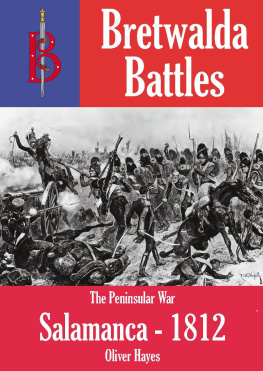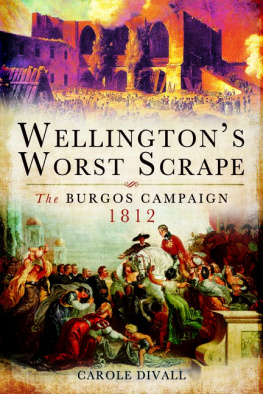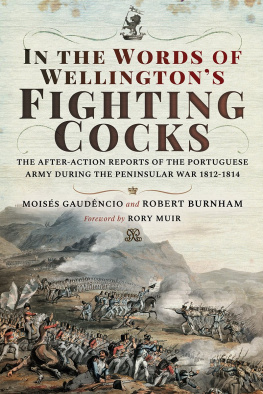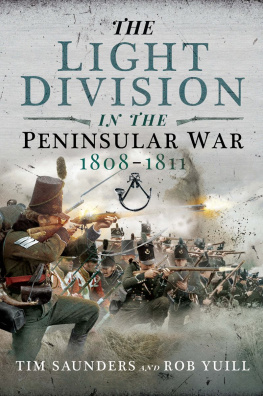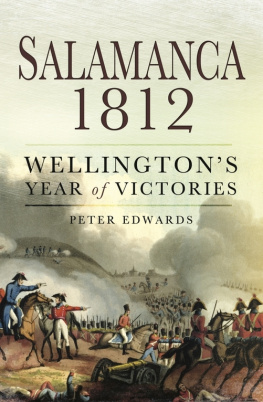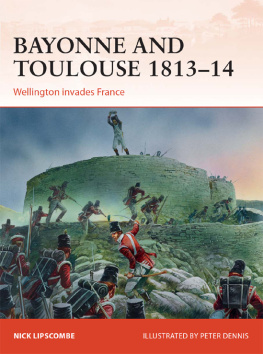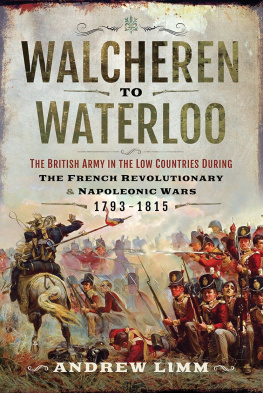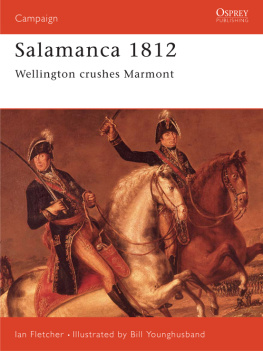Salamanca 1812
Rory Muir
YALE UNIVERSITY PRESS
NEW HAVEN AND LONDON
Copyright 2001 by Rory Muir
All rights reserved. This book may not be reproduced in whole or in part, in any form (beyond that copying permitted by Sections 107 and 108 of the U.S. Copyright Law and except by reviewers for the public press) without written permission from the publishers.
For information about this and other Yale University Press publications, please contact:
U.S. Office:
sales.press@yale.edu
www.yale.edu/yup
Europe Office:
sales@yaleup.co.uk
www.yalebooks.co.uk
Set in Ehrhardt by Fakenham Photosetting Limited, Norfolk Printed in Great Britain by St Edmundsbury Press, Suffolk
Library of Congress Cataloging-in-Publication Data
Muir, Rory, 1962
Salamanca 1812/by Rory Muir.
p. cm.
Includes bibliographical references and index.
ISBN 0300087195 (cloth)
1. Salamanca (Spain), Battle of, 1812. 2. Wellington, Arthur Wellesley, Duke of, 17691852.
DC233.S2 M85 2001
940.2'7dc21 2001026883
A catalogue record for this book is available from the British Library.
10 9 8 7 6 5 4 3 2 1
Contents
Maps and Plans
Maps and plans on pages 8, 49, 53, 63, 89, 99, 125, 127 and 150 drawn by Chris Crothers at the Department of Geographical and Environmental Studies of the University of Adelaide.
Abbreviations
| AAG | Assistant Adjutant-General |
| BL | British Library |
| DAAG | Deputy Assistant Adjutant-General |
| DAQMG | Deputy Assistant Quartermaster-General |
| JSAHR | Journal of the Society for Army Historical Research |
| KGL | King's German Legion |
| Lamartinire | Official French casualty return for the period 18 July to 8 August 1812 by Gnral Lamartinire, Chef d'Etat-Major de l'Arme du Portugal in French archives (AHG C715: see Appendix III and Bibliography) |
| Martinien | A. Martinien, Tableaux par Corps et par Batailles des Officiers Tus et Blesss pendant les Guerres de l'Empire (18051815) (Paris, Editions Militaires Europenes, nd [1980s], first published 1899) and the Supplment (Paris, Fournier, 1909) |
| NAM | National Army Museum, Chelsea |
| NAS | National Archives of Scotland, Edinburgh |
| NLS | National Library of Scotland, Edinburgh |
| Ordnance map | Cartografia Militar de Espaa, Mapa General Serie L, Salamanca 1319 (478) E. 1:50,000 (1993) |
| PRO | Public Record Office, Kew |
| USJ | United Service Journal (variations on the title include Colburn's United Service Journal and United Service Magazine) |
| Wyld's Atlas | Maps and Plans Showing the Principal Movements, Battles and Sieges in Which the British Army Was Engaged during the War from 1808 to 1814 in the Spanish Peninsula and the South of France (London, James Wyld, 1841) (Maps surveyed by Sir Thomas Mitchell in the years after the war) |
Preface
The battle of Salamanca was Wellington's finest victory. It lacks the fame and the awful grandeur of the bloody slog on the slopes of Mont St Jean, but technically it was far superior. Of all Napoleon's victories, only Austerlitz, Friedland and possibly Rivoli can be compared to its daring conception and skilful execution. After four days of careful, patient manoeuvring in which any mistake could easily have been fatal, Wellington recognized a fleeting opportunity and was able to grasp it. For the first time in the Peninsular War the allied army attacked in the open field, and the French were routed with enormous losses. A French officer described the result as the beating of forty thousand men in forty minutes, and although this is an exaggeration making the action appear less hard-fought than was the case it captures the enormous shock suffered by French pride and morale. Never again would the French offer Wellington battle in the Peninsula with such confidence, and this was as significant as the liberation of Madrid, the raising of the siege of Cadiz and the French evacuation of Andalusia, all of which resulted from the victory.
Despite its importance, Salamanca has received surprisingly little attention. In almost two hundred years only three slight books, all aimed at a popular or uncritical audience, have appeared describing the campaign and the battle. These works are rightly overshadowed by the famous histories of the war in the Peninsula as a whole, beginning with Napier and including Fortescue's History of the British Army and Sarramon's more recent work. The best of these for Salamanca is Sir Charles Oman's History of the Peninsular War. Oman's description of the battle is well written, fair and perceptive, illustrated with lively quotations and supported by two invaluable appendices of statistics. It advanced our knowledge far beyond previous accounts and remains the starting point for any new study of the battle. Nonetheless, Oman's account occupies just two chapters out of the twenty-four in a fat volume which covers many other operations, including the sieges of Ciudad Rodrigo and Badajoz and campaigns in Valencia, Andalusia and other parts of Spain. As a result Oman lacks the space to explore fully all the issues raised by the battle. Furthermore, it is almost ninety years since his account was first published, and in that time many new sources have come to light which greatly enrich our understanding of the battle.
The purpose of the present work is to give a detailed account of what happened on 22 July 1812. This apparently simple objective has proved surprisingly difficult to achieve in practice. There is no shortage of sources: scores of officers and men wrote accounts of their experiences either in diaries or letters soon afterwards, or in reminiscences years later, and these personal narratives can be tested against casualty statistics of varying reliability and by visiting the battlefield, which remains today substantially as it was in 1812. But while the sources are plentiful, they do not always fit neatly together; indeed, they are riddled with contradictions, inconsistencies, gaps and uncertainty. Sometimes the only account of an important incident comes from a dubious source; and sometimes two apparently reliable sources flatly contradict each other. The sources are numerous, but not evenly distributed: a great number of British soldiers published their recollections of the battle; far fewer Frenchmen wished to recall their defeat; while Portuguese voices except for British officers serving in Portuguese units have proved elusive.
Normally the historian deals privately with these problems, occasionally drawing attention to a particularly thorny issue in the text perhaps when a novel interpretation is advanced while alluding briefly to some other difficulties in the notes. This method is inescapable in addressing a large, sweeping subject if the narrative is not to lose its momentum and the reader to miss the thread of the argument. However, it can also mislead the reader by suggesting that our understanding is far more securely based than is the case. Most casual readers of Oman's account of Salamanca probably come away with the impression that there are only a few outstanding difficulties, and that these would be solved easily if fresh evidence came to light.
In fact, almost every aspect of the battle has its complexities, if not its contradictions. I want to explore these problems and examine the various gradations between what we know as surely as we know anything about the past (that a battle was fought a few miles south of Salamanca on 22 July 1812 in which the French were defeated), through what is debatable (the formation of Pakenham's division in its advance, or who gave the order for Pack's attack on the Greater Arapile), to the point where the evidence fails completely. In other words I want to show the reader the historian's building site before the scaffolding has been taken down, the tools put away and the debris swept out of sight. Thus, at one level the subject of the book is the battle of Salamanca; at another, it is a case study of the problems encountered in answering even the comparatively simple historical question of what happened at a particular place on a particular day. Not that I wish to venture into the theoretical or philosophical issues underpinning the writing of history: my objective is much more modest to show how a simple empirical study is constructed, and how source problems are addressed.
Next page


